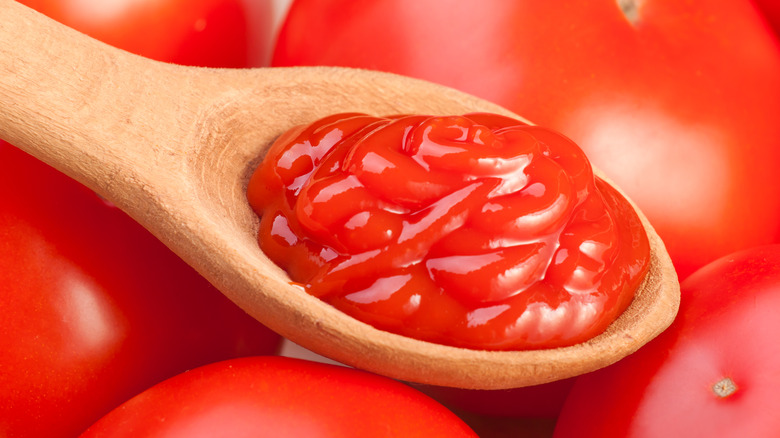How (And When) To Substitute Ketchup For Tomato Sauce
You might think that ketchup and tomato sauce aren't the kind of ingredients you can substitute for each other. But with some creative thinking, there are ways to make some swaps in a pinch.
If you have a spaghetti and meatball dinner in mind but forgot the can of tomato sauce, ketchup may not be your savior. While it does have ingredients that could work, like tomato concentrate, salt, and onion powder, it also typically contains quite a bit of sweetener, such as corn syrup or sugar. Even "no sugar added" products often contain something like stevia extract, while unsweetened ketchups still attempt to mimic the taste of the regular variety with relatively sweet ingredients like balsamic vinegar. In contrast, a canned tomato sauce likely has just tomato puree, spices, and salt, depending on the brand.
Because of ketchup's sweetness, it can only really stand in when the recipe calls for tomato sauce as one of several ingredients — not the star of the show. Dishes like bolognese or lasagna sauce are probably out. However, slow cooker meals, pot roasts, glazes, casseroles, meatloaf, and beans could all handle the swap. In these cases, you can substitute ketchup for tomato sauce in a one-to-one ratio, but adjust the recipe to balance out the sweetness.
Modifying ketchup to replace tomato sauce
When you're swapping tomato sauce for ketchup, consider the flavor profile you are trying to create, and look at the other ingredients in the recipe. You can simply increase the amount of spices or acid called for to help balance out the sweetness of the ketchup. You also may want to put the ketchup in a separate bowl and mix in whatever additions you like. That way, it will be easier to taste and adjust as you go, and it's less risky than experimenting with a whole pot of food.
Spices and fresh herbs are key to making ketchup taste less ketchup-y, so it's good to be a little heavy-handed in this case. For an Italian-inspired dish, lean into ingredients like basil, rosemary, garlic, and red pepper flakes. For a Mexican-ish preparation, try cumin, chili powder, cilantro, or oregano. A bit of tanginess in the form of citrus, vinegar, or cultured dairy can help to balance out sweetness, as well. Salty and savory additions like Worcestershire, soy, tamari, or a bit of bouillon are great too — just exercise caution since ketchup is already on the salty side.
A number of tomatoey recipes are built off of ketchup from the start. Even chef Jacques Pépin often uses the controversial condiment for glazing ham, saucing salmon, and flavoring creamy dips. Something like a sloppy joe sandwich recipe that is based around ketchup instead of tomato sauce can save you the substitution guesswork.
How to substitute tomato sauce for ketchup
When faced with the opposite problem, you can also substitute tomato sauce for ketchup. In this case, you'll want to introduce some sweetness, which essentially means a homemade ketchup recipe. Don't worry — making ketchup is actually pretty easy. All sorts of products can be used as a base, including crushed tomatoes, puree, paste, fresh tomatoes, and even canned tomato sauce. Simply cook down the tomatoes with onions, garlic, sugar, vinegar, and spices like ground mustard, cloves, cinnamon, or cayenne pepper. When it looks like ketchup, it's done! For a smoother texture, you can pass it through a fine-mesh sieve.
Depending on how watery your tomato sauce is, cooking it down to ketchup consistency can be a little time-consuming. A shortcut method is to mix about one cup of tomato sauce, half a cup of sugar, and a couple of tablespoons of vinegar. This should provide the sweetness and tang of ketchup, but the texture will be thinner. To compensate, either reduce the liquid in another part of the recipe, or allow for a longer cooking time so more moisture evaporates.



